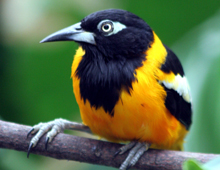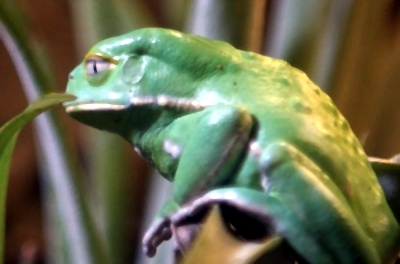Orinoco

Sunbittern, Eurypyga helias
Another relative of cranes and rails, this Central and South American forest bird is not related to true bitterns, which are herons. When alarmed, it spreads its brilliantly colored wings, completely transforming its appearance. It was first bred in captivity more than 140 years ago, at the London Zoo, and has bred in many places since, including the DWA.
LEARN MORE
Grey-winged trumpeter, Psophia creptitans
Distant relative of cranes, rails, and bustards, trumpeters are found only in the forests of South America. They are named for their complex vocalizations, which sometimes sound if they are producing several sounds at the same time. Though capable of flight, they are usually on the forest floor. Much of the food is fruit that falls out of trees, and they are often beneath troops of monkeys, waiting for the fruit they drop.
LEARN MORE
Red-breasted toucan, Ramphastos dicolorus
Found in Brazil, Paraguay and Argentina, this species remains fairly common despite continuing habitat loss and some hunting pressure (toucans are eaten by people in some places). Though presently rare in collections, it was the first of the Ramphastos toucans bred in captivity, in Germany in 1967. It has also set the age record for any member of its family, one having lived 27 years, and another possibly 32 years. The DWA specimens arrived through the cooperation of the Brazilian Federal wildlife agency, IBAMA.
LEARN MORE
Blue-crowned motmot, Momotus momota
Found from Mexico to Argentina, this brilliantly-colored kingfisher relative is the only one of the nine members of the Tropical American motmot family to be widely kept in zoos, where many have bred. Eggs are laid in burrows dug in the earth. The remarkable pendulum-like tail develops normally at first, but parts of two feathers are shed as they develop, resulting in “racquets”. The strange name may be derived from this bird’s whooping calls.
LEARN MORE
Troupial, Icterus icterus
The National Bird of Venezuela, this South American oriole has been a prized cage bird for more than 150 years. The painter, Henri Mattise, included one in his collection of tropical birds that he kept to “tune his colors”. They are sometimes known as “Bugle Birds” for their piercing, melodious voices. Chicks have hatched at the DWA.
LEARN MORE
Pompadour cotinga, Xipholena punicea
Depending on the light, males may appear black, bright red, pink, or purple. Research conducted at Yale University’s Peabody Museum of Natural History, with the assistance of the DWA, has established that this species’ color is due to unique carotenoid pigments previously unknown in birds.
LEARN MORE
Guira cuckoo, Guira guira
Before the 1990s, this small Southern South American relative of the roadrunner was rare in captivity. In the last 15 years, many have been bred in US zoos. Zoo-bred specimens, like all the Guiras at the DWA, can be delightfully tame. Some may follow visitors as they walk through the Orinoco.
LEARN MORE
Andean cock-of-the-Rock, Rupicola peruvianus
Every year since 2007, this remarkable bird has reproduced at the DWA. Through May 2011, 40 had hatched here, with 26 surviving to independence. Prior to this time, the total number successfully reared in US zoos were four at Houston and one at San Diego, with the last hatching occurring in 1989. Offspring from the DWA have been sent around the world, and the first second generation breedings took place at the San Diego Zoo in 2011, with males from Dallas. While performing their courtship display, males make buzzing shrieks that can be heard throughout the Orinoco. Nesting takes place in specially built artificial caves.
LEARN MORE
Emerald tree boa, Corallus caninus
This beautiful snake is found in the rainforests across a large area of South America. Unlike its more famous relatives, the Boa constrictor and the Anaconda, it only reaches a length of about six feet. It has the longest fangs in proportion to its size of any living snake. Females give birth to as many as 20 young, which do not attain their bright green color until they are around nine months old. Until then, they are orange or dark red. In recent years it has been regularly bred in captivity.
LEARN MORE
Waxy monkey tree frog, Phyllomedusa sauvagei
This inhabitant, of the dry Chaco forests in Southeastern South America, has developed some decidedly unfrog-like behaviors. Instead of laying its eggs in water, it builds a nest above it, laying eggs on a leaf, which it folds around them. There the tadpoles hatch, then fall into the stream below. It smears its body with wax secreted out of its own skin, using complicated maneuvers of its hind legs. Its unusually expressive appearance has made it popular in zoos, and it is now captive-bred in increasing numbers.
LEARN MORE

